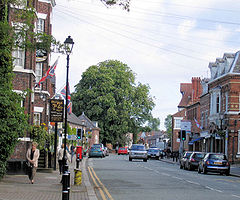Tarporley
| Tarporley | |
|---|---|
 High Street |
|
| Tarporley shown within Cheshire | |
| Population | 2,614 (2011 Census) |
| OS grid reference | SJ553627 |
| Civil parish |
|
| Unitary authority | |
| Ceremonial county | |
| Region | |
| Country | England |
| Sovereign state | United Kingdom |
| Post town | TARPORLEY |
| Postcode district | CW6 |
| Dialling code | 01829 |
| Police | Cheshire |
| Fire | Cheshire |
| Ambulance | North West |
| EU Parliament | North West England |
| UK Parliament | |
Tarporley is a large village and civil parish in Cheshire, England. It is bypassed by the A49 and A51 roads, and holds a regular country market on the first Saturday of each month.
At the 2001 Census, the population was 2,634, falling slightly to 2,614 at the 2011 Census. Tarporley civil parish also contains the village of Rhuddall Heath. Since 2009 it forms part of the unitary authority district of Cheshire West and Chester.
Tarporley High Street features four pubs: the Foresters Arms, the Swan Hotel, the Crown Hotel, and the Rising Sun. The High Street is also home to four restaurants: Piste, The Coast Restaurant and Bar, Little Tap, and STREET Tarporley.
The Tarporley Hunt Club, the oldest surviving hunt club in England, meets in the village every Christmas.
An electoral ward of the same name exists. This ward stretches north-east to the Budworths with a total population at the 2011 Census of 4,398.
The Urban District of Tarporley was created in 1894 and was abolished in 1936. From 1936 until 1974 Tarporley was a part of the Rural District of Northwich, until that district's abolition as a result of the Local Government Act 1972. From 1 April 1974 Tarporley formed part of the borough of Vale Royal, within Cheshire and was included in the new unitary authority of Cheshire West and Chester on 1 April 2009. The village has civil parish status and its own parish council, giving it some limited local government autonomy. The parish council comprises 12 locally elected members.
Tarporley has been in the parliamentary constituency of Eddisbury since that constituency's re-establishment in 1983, following its abolition in 1950.
...
Wikipedia

